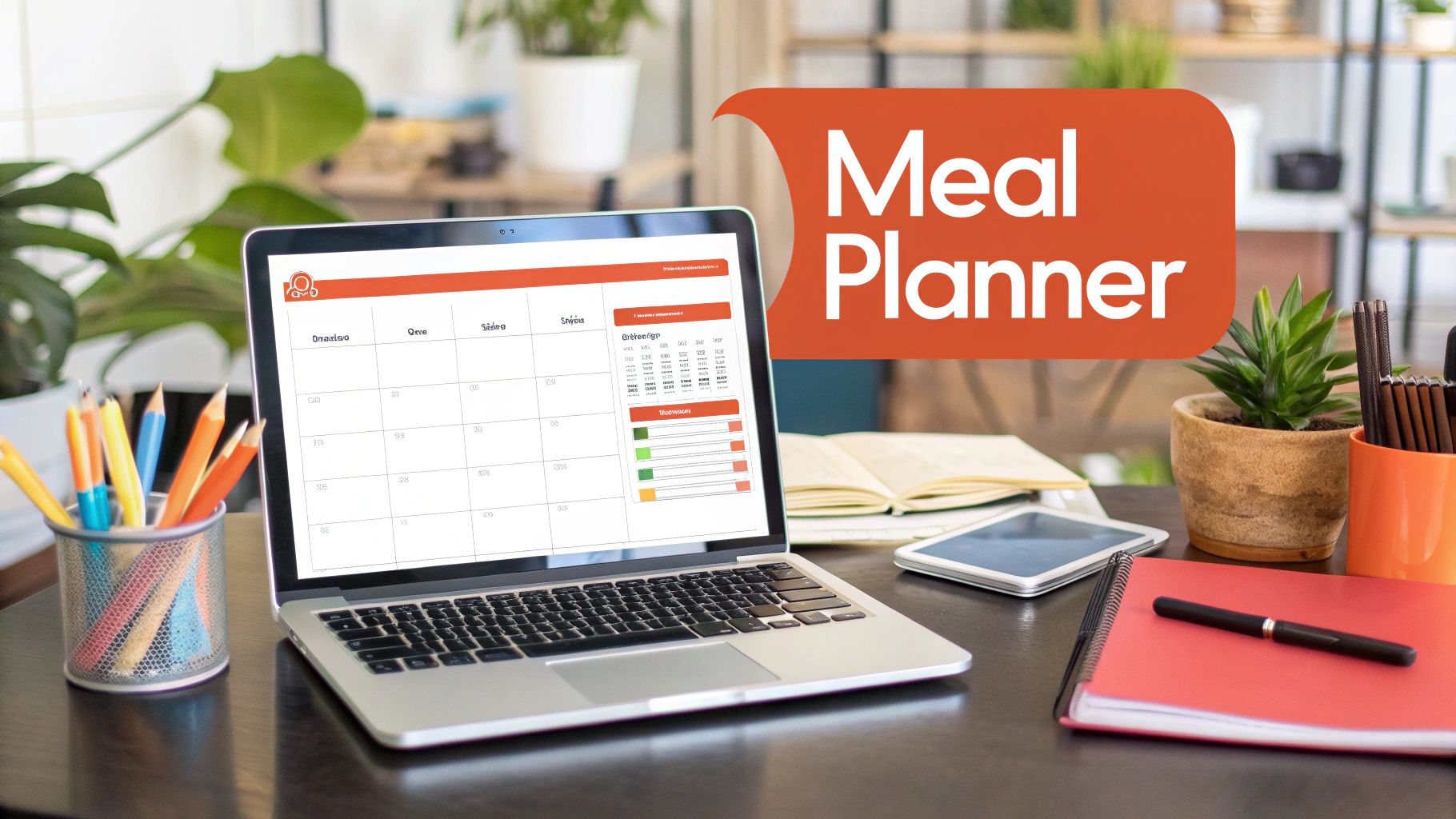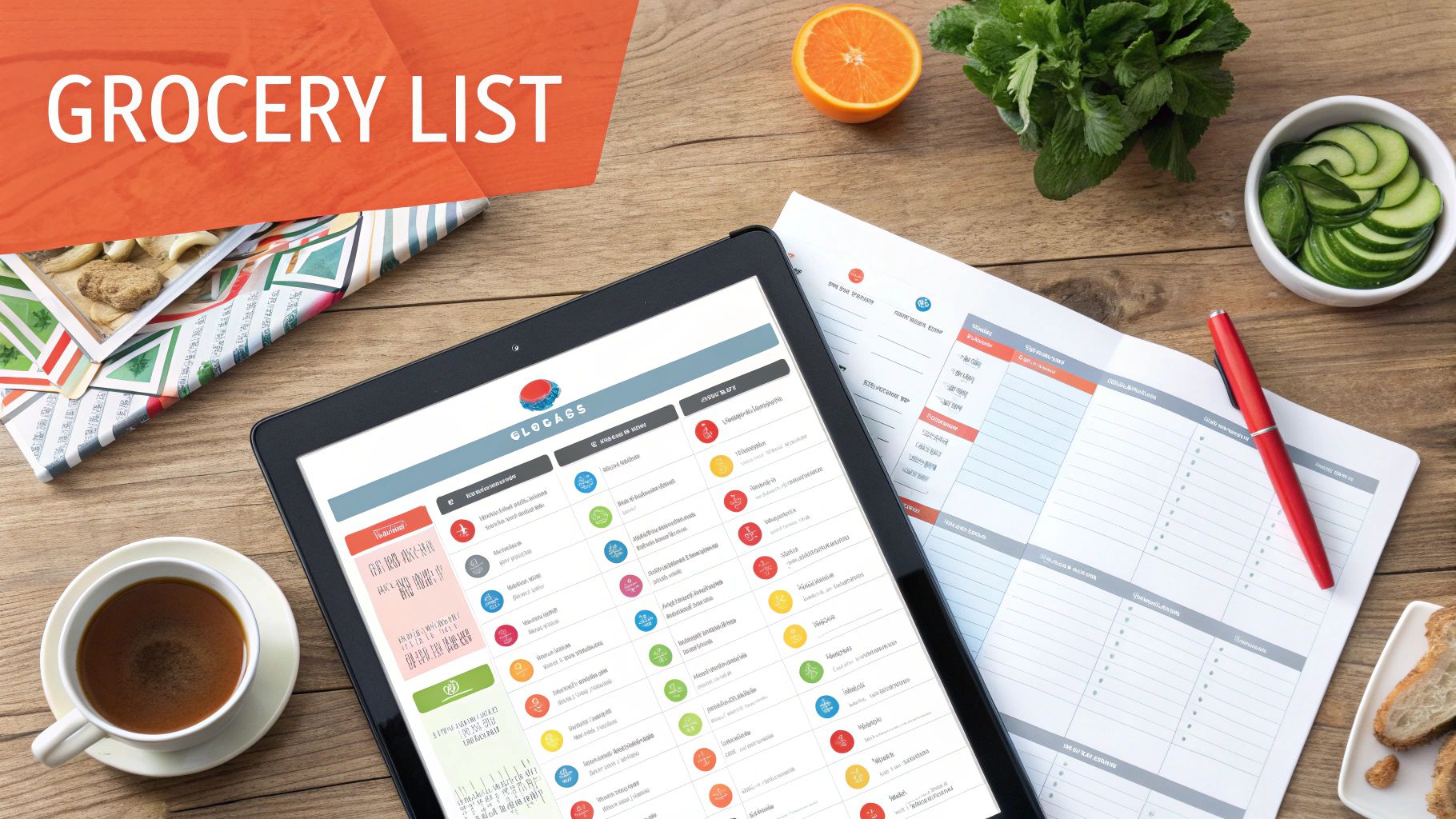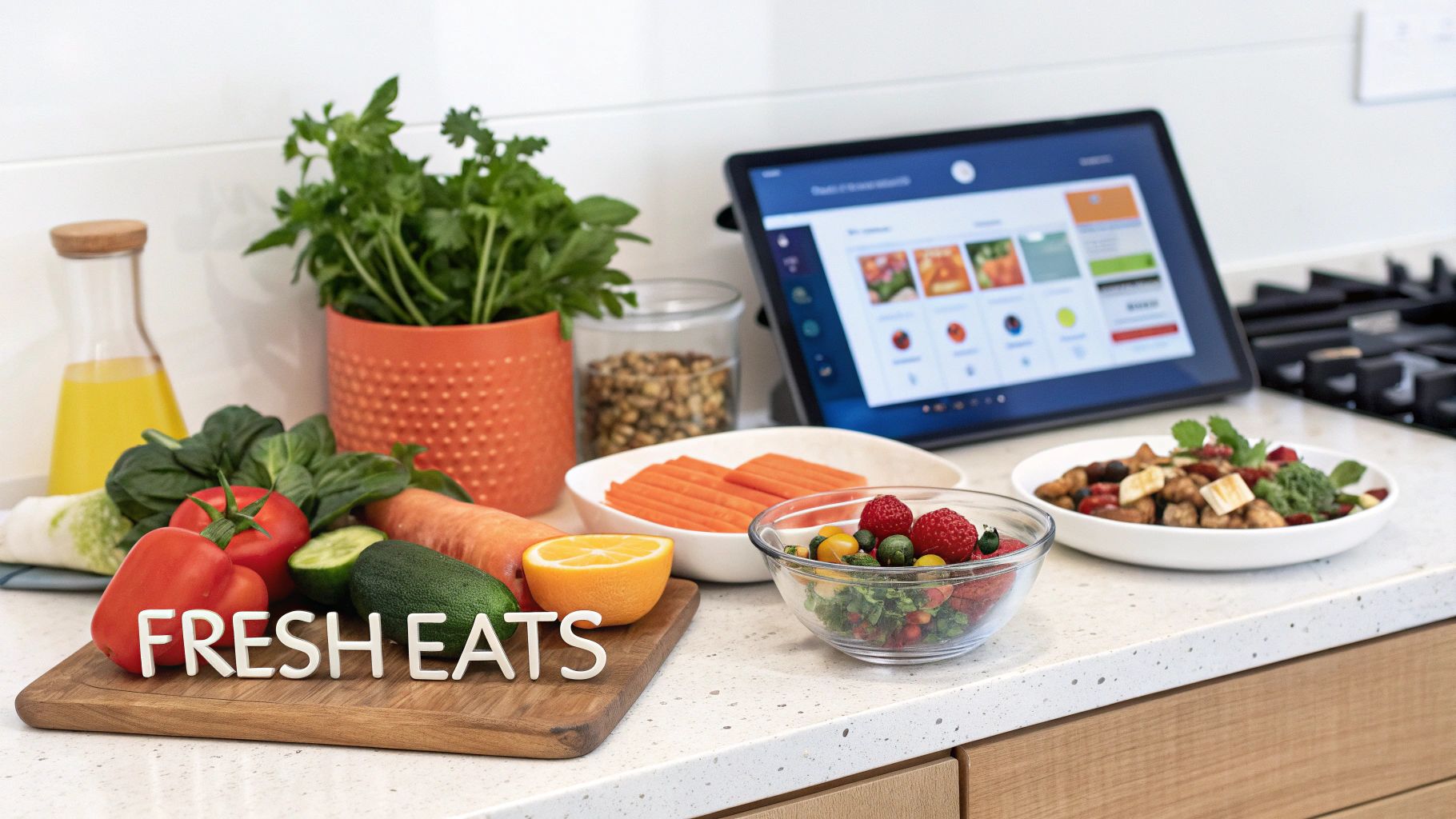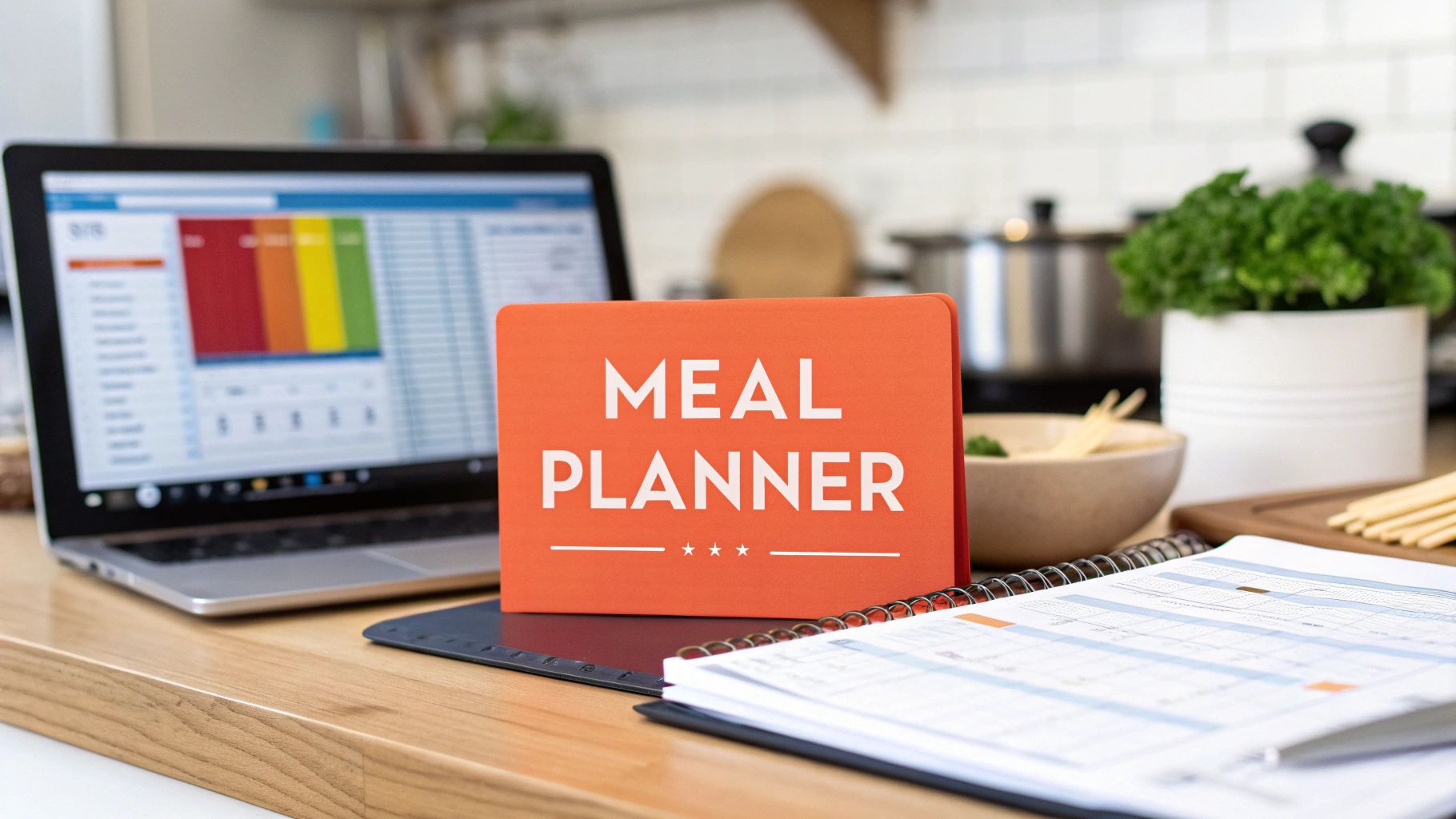Why Smart Planners Use Meal Planning Spreadsheet Templates

In our busy lives, figuring out dinner can be a daily struggle. Constantly deciding what to eat often leads to unhealthy impulse purchases and, unfortunately, wasted food. Meal planning spreadsheet templates offer a practical solution. They provide a simple yet effective way to organize your meals and take back control of your kitchen. This means less stress around food and more time to enjoy it.
A meal planning spreadsheet template gives you a structured way to plan breakfast, lunch, and dinner for each day of the week, or even the whole month! This advance planning eliminates daily decision fatigue, freeing up mental energy for other things. Plus, a clear overview of your planned meals makes grocery shopping more efficient. You'll buy only what you need, reducing food waste and staying on budget.
Benefits of Using a Meal Planning Spreadsheet Template
-
Reduced Mental Load: Say goodbye to the daily stress of deciding what to eat by planning ahead.
-
Efficient Grocery Shopping: Create precise shopping lists based on your meal plan, minimizing those tempting impulse buys.
-
Minimized Food Waste: By buying only what you need, you'll drastically reduce the chances of ingredients spoiling before you use them.
-
Healthier Eating Habits: Plan balanced meals that include a variety of nutrients and align with your dietary goals.
-
Cost Savings: Reducing food waste and sticking to your grocery budget translates to real savings over time.
Meal planning spreadsheets are gaining popularity as a way to organize meals and reduce food waste. A major benefit is the ability to effectively track and manage calories, macronutrients, and ingredients. For example, a monthly meal plan spreadsheet template lets you plan up to a month in advance, ensuring all the details are covered. This helps maintain a balanced diet and makes budgeting easier by providing a complete list of necessary ingredients and their quantities. Retable offers interactive templates you can customize for personal or family needs. Using these templates can save time and money, with some users reporting annual savings in the thousands. Explore this topic further on their site.
Choosing the Right Meal Planning Spreadsheet Template
The best template depends on your individual needs and preferences. Some templates are for basic meal planning, while others offer advanced features like nutrition tracking and automatic grocery list generation.
Here’s a simple comparison:
| Feature | Basic Template | Advanced Template |
|---|---|---|
| Meal Planning | Yes | Yes |
| Grocery List | Sometimes | Often |
| Nutrition Tracking | No | Yes |
| Recipe Integration | No | Sometimes |
| Cost | Free | Free or Paid |
The right meal planning spreadsheet template empowers you to take charge of your meals. This leads to a healthier, more organized, and less stressful experience in the kitchen. This proactive approach not only simplifies your daily routine but also sets you up for long-term success with your health and financial goals. Start your journey towards a more organized and enjoyable cooking experience by choosing a template that fits your lifestyle.
The Hidden Financial Power of Meal Planning Templates

A meal planning spreadsheet template isn't just about organizing your meals. It's a powerful tool for taking control of your finances. Beyond simply reducing food waste, a well-structured meal plan can significantly impact your overall budget. Think of your meal planning spreadsheet template as a financial advisor for your kitchen.
It helps you make informed decisions about your food spending, leading to noticeable savings over time.
Unveiling the Cost Savings
Planning your meals creates a roadmap for your grocery shopping. This targeted approach helps you avoid impulse purchases and stick to your budget. For example, if you know you’re making chicken stir-fry on Wednesday, you'll buy only the necessary ingredients. You’ll be better at resisting the temptation to grab extra snacks or other unplanned items.
This mindful shopping translates directly into savings. Pre-planning also allows you to incorporate leftovers strategically, stretching your food budget even further. This means fewer grocery store trips and less money spent on takeout or restaurant meals.
Using meal planning spreadsheets can lead to substantial financial savings. By organizing meals in advance and creating shopping lists, you avoid impulse buys and minimize food waste. This has been reported to save households thousands of dollars annually. Tiller offers templates with features such as automated meal planning and grocery list generation, further enhancing efficiency.
Let's take a closer look at some potential savings. The table below illustrates how meal planning can impact your spending across several categories.
Potential Annual Savings With Meal Planning
Breakdown of estimated financial savings achievable through consistent use of meal planning spreadsheets.
| Spending Category | Without Planning | With Planning | Annual Savings |
|---|---|---|---|
| Groceries | $600/month | $450/month | $1800 |
| Eating Out | $200/month | $100/month | $1200 |
| Food Waste | $50/month | $20/month | $360 |
| Total Annual Savings | $3360 |
As this table demonstrates, the combined savings from groceries, eating out, and reduced food waste can result in significant annual savings.
Maximizing Your Savings With a Meal Planning Spreadsheet Template
-
Strategic Bulk Buying: Identify frequently used ingredients and buy them in bulk, saving money in the long run.
-
Reduced Impulse Purchases: With a clear plan, you're less likely to fall prey to tempting impulse purchases at the grocery store.
-
Optimized Grocery Budgets: Knowing exactly what you need helps optimize your grocery budget, allocating funds more efficiently.
-
Tracking Financial Progress: Track your grocery spending over time. This helps you identify areas where you can save even more and see the positive financial impact. How to Master Recipe Organization offers some further helpful tips.
Balancing Cost-Effectiveness With Other Goals
While cost savings are significant, meal planning offers additional benefits. It helps you achieve your nutritional goals by ensuring balanced meals. Efficient planning also saves you valuable time, allowing you to focus on other priorities.
A meal planning spreadsheet template helps you strike a balance between cost-effectiveness, healthy eating, and time management. This creates a sustainable approach that benefits both your wallet and your well-being.
Crucial Features That Transform Good Meal Planning Spreadsheet Templates Into Great Ones

What makes a meal planning spreadsheet template truly great? It's more than just a digital calendar. The best templates offer thoughtful features that encourage consistent use and deliver real results, changing how you approach mealtimes. It's about creating a system that works for you.
Customizable Fields: Making the Template Your Own
Great meal planning spreadsheet templates recognize that everyone's needs are different. Customizable fields are key. They let you tailor the template to your specific requirements, whether it's tracking portion sizes, managing dietary restrictions, or simply noting favorite recipes. This flexibility ensures the template fits your lifestyle. A personalized approach leads to greater long-term success.
Automatic Calculations: Streamlining the Process
Beyond simply listing meals, look for the power of automatic calculations. If you're tracking macronutrients or calories, a template that automatically calculates these values based on your recipes saves time and effort. This transforms your spreadsheet into a dynamic tool, giving you valuable nutritional insights. This efficiency is crucial for sustainable meal planning.
Integrated Shopping Lists: From Plan to Purchase
An integrated shopping list is another important feature. A great template automatically creates a shopping list from your meal plan, removing the need for manual list-making. Some templates even categorize your list by grocery store aisles for extra efficiency. This streamlined process saves you time and mental energy, encouraging consistent template use.
Choosing the Right Format: Excel, Google Sheets, or Apps?
The template's format matters too. Excel offers powerful formulas and offline access. Google Sheets allows for easy collaboration and cloud syncing. Specialized meal planning apps often provide features like recipe integration and nutrition databases. The best choice depends on your workflow. A busy family might prefer a collaborative Google Sheet, while someone planning solo might find Excel's offline capabilities more convenient. For more tips on recipe management, check out Recify.
Design & Psychology: Encouraging Consistent Use
Don't underestimate the importance of template design. A visually appealing and organized layout can boost your motivation to use it regularly. Consider color-coding to categorize meals or highlight dietary needs. A clear interface makes planning more enjoyable and less overwhelming. Even small design choices impact your long-term adherence to meal planning goals.
Flexibility and Evolution: Adapting to Your Needs
A great template adapts to your changing needs. Your dietary requirements, lifestyle, and preferences may evolve. A template that allows for flexibility is essential. This might involve adding categories, tweaking formulas, or even switching formats. This adaptability ensures your meal planning system remains a valuable tool. For a deeper dive into meal prepping, this resource offers a comprehensive guide.
Nutrition Tracking: Turning Templates Into Precision Tools

For those focused on health and fitness, a meal planning spreadsheet template can be much more than a simple weekly menu planner. It can become a powerful tool for precisely tracking your nutrition. And the best part? This precision doesn't have to sacrifice simplicity. Let's explore how fitness professionals and nutrition coaches use these templates to effectively track macronutrients while keeping the planning process manageable.
Customizing Your Template For Specific Dietary Needs
One of the biggest benefits of a meal planning spreadsheet template is its customizability. You can easily adapt your template to fit your specific dietary needs, whether you're following a keto, paleo, plant-based, or any other type of diet.
For example, if you're on a ketogenic diet, you can add columns to track net carbs and ensure you stay within your daily limits. Vegetarians can customize their templates to focus on plant-based protein sources. This customization allows for a highly personalized approach to meal planning and nutrition tracking.
Weekly macro meal planning is gaining popularity with fitness enthusiasts. These templates let users customize their meal plans by setting specific calorie goals and macronutrient ratios.
For example, a free weekly macro meal planner offers the flexibility to adjust daily calorie intake and the percentage of proteins, fats, and carbohydrates. This adaptable approach supports various dietary plans, whether for weight loss, muscle gain, or maintaining overall health. Many templates also auto-generate grocery lists, making the entire planning process much easier. Learn more about macro meal planning here.
Integrating Nutrition Data Sources and Building Sustainable Habits
You can integrate various data sources into your meal planning spreadsheet template for effective nutrition tracking. Many online databases and apps provide nutritional information for a wide variety of foods. By incorporating this data into your template, you can accurately calculate your calorie and macronutrient intake for each meal.
Building sustainable tracking habits is also essential. Start by tracking your food intake consistently for a few days each week. Gradually increase the frequency as you become more comfortable with the process.
Balancing Detailed Monitoring With Practical Implementation
While detailed nutrition tracking can be very helpful, it's important to find a balance between meticulous monitoring and practical application. Overly complex tracking systems can quickly become overwhelming and difficult to maintain.
Focus on tracking the key metrics most relevant to your goals, such as calories, macronutrients, or specific micronutrients. This simplified approach makes the tracking process more sustainable and increases your chances of long-term success.
Adapting Your Approach and Maintaining Consistency
Your health and fitness goals may change over time, and your tracking approach should adapt accordingly. For instance, if you're initially focused on weight loss, you might prioritize calorie tracking. As you progress, you might shift your focus to building muscle and start tracking your protein intake more closely.
Maintaining consistency during challenging periods, like travel or holidays, can be tough. Consider preparing meals in advance or using pre-portioned snacks to help you stay on track.
The following table provides an overview of various meal planning template formats and their features.
Comparing Meal Planning Template Formats
| Format | Macro Tracking | Shopping List Integration | Customization | Accessibility | Best For |
|---|---|---|---|---|---|
| Spreadsheet (Excel/Google Sheets) | High | High | High | High | DIYers, Data-Driven Individuals |
| Meal Planning Apps | Medium | High | Medium | High | Convenience, Recipe Integration |
| Printable Templates | Low | Low | Low | High | Basic Planning, Visual Learners |
By understanding the different formats available and leveraging the power of your meal planning spreadsheet template, you can gain greater control over your nutrition and achieve your health and fitness goals. For more tips and tools to improve your recipe organization, check out Recify.
Household Harmony: Family-Focused Planning Templates
Coordinating meals for a family with diverse tastes and schedules can be challenging. Family-focused meal planning spreadsheet templates offer a solution, transforming mealtimes from a source of stress into an opportunity for connection. How can you create a system that works for everyone?
Accommodating Diverse Tastes and Dietary Needs
A successful family meal plan considers everyone's preferences and nutritional needs. Think of your meal planning spreadsheet template as a collaborative tool. Include columns for each family member to suggest meals, fostering ownership and enjoyment.
Consider dietary restrictions and allergies. Color-coding can be helpful. For instance, highlight vegetarian meals in green and gluten-free meals in yellow, ensuring everyone's needs are met efficiently.
Streamlining Schedules and Reducing Mealtime Tension
Busy family schedules often clash with mealtimes. A meal planning spreadsheet template helps navigate these conflicts. Plan meals around busy evenings, opting for quick and easy options when time is short. This reduces the likelihood of last-minute takeout and encourages healthier eating.
Assigning meal preparation responsibilities within the template fosters teamwork. This not only distributes the workload but also teaches children valuable cooking skills. Older children could prepare a side dish, while younger children set the table. These shared responsibilities transform meal preparation into a family activity, easing tension and building bonds. Digital tools like Glide offer no-code meal planning templates, enabling families to contribute meal ideas and generate shopping lists automatically. This encourages family involvement and simplifies meal preparation. Using digital templates helps avoid repetitive meals, reduce food waste, and ensure everyone’s preferences are considered. Learn more about interactive family meal planning here. These templates can also be customized.
Transforming Family Dynamics Around Food
A well-designed meal planning spreadsheet template can be more than just an organizational tool; it can positively change family dynamics. Involving everyone in the planning process creates shared responsibility and open communication about food. This fosters a positive and relaxed mealtime atmosphere.
Consider a weekly "theme night," like "Taco Tuesday" or "Pizza Friday," to add a fun and predictable element. Theme nights can also be educational, exploring different cuisines and cultures together.
Teaching Children About Nutrition and Cooking
Meal planning templates can be valuable teaching tools for nutrition and cooking. Use the template to introduce basic nutrition concepts, discussing balanced meals and food groups. Involve children in choosing healthy recipes and researching nutritional information.
Meal planning is a natural platform for teaching cooking skills. Start with simple tasks and gradually introduce more complex techniques. These shared kitchen experiences build valuable life skills and create lasting memories. For insights into categorizing recipes, visit our blog on recipe organization. Leveraging meal planning spreadsheet templates transforms mealtimes from chaotic obligations into opportunities for connection, learning, and enjoyment.
From Generic to Perfect: Customizing Your Template
A generic meal planning spreadsheet template offers a solid foundation, but customizing it is what truly unlocks its power. Think of it like a basic house blueprint – functional, but lacking that personal touch. Customizing your template transforms it into your personalized kitchen command center. This section will guide you through the steps to make that happen.
Modifying Layouts: Creating a Visually Appealing and Functional Plan
Start by adjusting the template's layout. If you're a weekly planner, dedicate a column for each day. For monthly planning, consider a calendar-style view. Experiment with different fonts and colors to make it easier to read. For example, use bold text for meal titles and softer colors for different meal categories. This seemingly small step can significantly impact how often you use your template.
Implementing Time-Saving Formulas: Automating Calculations
Now, let's introduce the magic of formulas in Microsoft Excel or Google Sheets. If you’re tracking calories or macronutrients, use formulas to calculate totals automatically. Imagine entering your ingredients and instantly seeing the total carbs, protein, and fat. This eliminates manual calculations and reduces errors. You can also create formulas to scale recipes up or down based on serving sizes, ensuring accurate ingredient amounts. This streamlined approach saves time and encourages consistent spreadsheet use.
Incorporating Personalized Categories: Reflecting Your Unique Needs
There’s no one-size-fits-all approach to meal planning. Incorporate personalized categories to reflect your lifestyle. Are you focused on specific cuisines, dietary restrictions, or cooking methods? Add columns for these categories. This makes it easier to filter and sort your meal plan, saving you time and energy. You might find this article helpful: How to master recipe categorization. Custom categories transform a generic template into a tool designed specifically for you.
From Simple to Advanced: Strategies for Template Evolution
Start with basic customizations. As you become more comfortable, explore advanced features like conditional formatting in your chosen spreadsheet software. For instance, you could set cells to automatically highlight meals exceeding certain calorie limits. Or, use drop-down menus for ingredient selection to speed up data entry. These gradual enhancements increase your spreadsheet’s efficiency and prevent it from becoming overwhelming.
Troubleshooting and Expert Tips: Maintaining Efficiency and Personalization
Even the best-laid plans can encounter bumps in the road. If your spreadsheet becomes slow, try simplifying complex formulas or splitting your plan into separate sheets. If data entry feels tedious, create a master list of frequently used ingredients with their nutritional information. This allows for quick copy-and-pasting into your meal plan. Remember, the goal is to balance efficiency and personalization. Your meal planning spreadsheet should be a helpful tool, not a source of stress.
Making It Stick: Building Sustainable Planning Habits
The true power of a meal planning spreadsheet template lies in its consistent use. Like any new skill, incorporating meal planning into your daily life takes effort and a few smart strategies. It's about finding a rhythm that works for you and establishing lasting habits. This section explores techniques to seamlessly integrate your meal planning spreadsheet template into your lifestyle. You might find this helpful: How to master meal prepping for beginners.
Efficient Approaches to Template Maintenance
Maintaining your meal planning spreadsheet template shouldn't be a chore. Think of it as nurturing a garden – a little regular attention produces great results. Time-saving shortcuts are key. For instance, build a master list of your family's favorite meals within the spreadsheet itself. This lets you quickly drag and drop meals into your weekly plan, eliminating repetitive typing.
Batch planning is another useful technique. Rather than planning one week at a time, dedicate a couple of hours each month to plan multiple weeks in advance. This saves time and provides a broader view of your dietary goals.
Preventing Meal Planning Fatigue: The Power of Recipe Rotation
Recipe rotation is essential to avoid meal planning burnout. Develop a system for rotating your go-to recipes, ensuring you're not eating the same things every week. This maintains variety and prevents boredom. Imagine it as a DJ's playlist – keeping your meals fresh and exciting.
Balancing Structure With Flexibility
Structure is essential, but your meal planning also needs flexibility. Life is unpredictable, filled with unexpected events, changing preferences, and seasonal shifts. A rigid system will likely break down under pressure.
Embrace spontaneity. Set aside one day a week as a "flexible meal" day. This could be takeout, leftovers, or a quick meal from your pantry. This prevents your meal plan from becoming too restrictive.
Practical Habit-Building Techniques and Tracking Progress
Tracking progress is key for establishing sustainable habits. Begin with small steps. Commit to planning just one week of meals at first. Celebrate your accomplishments and gradually increase your planning frequency.
Track progress in different ways. Monitor your grocery expenses, record how often you adhere to your plan, and observe any changes in your stress levels during mealtimes. Seeing tangible results reinforces good habits and promotes ongoing use of your meal planning spreadsheet template.
Ready to improve your meal planning with a powerful, personalized tool? Recify simplifies recipe storage and organization, integrating seamlessly with your planning process. Check out Recify today and take control of your kitchen!
